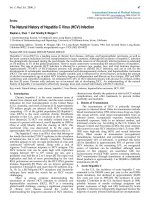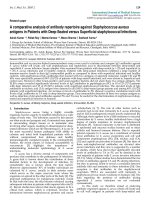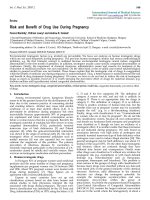Báo cáo y học: "Monte Carlo Commissioning of Low Energy Electron Radiotherapy Beams using NXEGS Software"
Bạn đang xem bản rút gọn của tài liệu. Xem và tải ngay bản đầy đủ của tài liệu tại đây (250.08 KB, 13 trang )
Int. J. Med. Sci. 2004 1(2): 63-75
63
International Journal of Medical Sciences
ISSN 1449-1907 www.medsci.org
©2004 Ivyspring International Publisher. All rights reserved
Monte Carlo Commissioning of Low Energy Electron
Radiotherapy Beams using NXEGS Software
Research paper
Received: 2004.3.02
Accepted: 2004.5.12
Published:2004.6.01
Joseph A. Both, Todd Pawlicki
Department of Radiation Oncology, Stanford University School of Medicine, Stanford,
CA 94305, USA
A
A
b
b
s
s
t
t
r
r
a
a
c
c
t
t
This work is a report on the commissioning of low energy electron beams
of a medical linear accelerator for Monte Carlo dose calculation using
NXEGS software (NXEGS version 1.0.10.0, NX Medical Software, LLC).
A unique feature of NXEGS is automated commissioning, a process
whereby a combination of analytic and Monte Carlo methods generates
beam models from dosimetric data collected in a water phantom. This
study uses NXEGS to commission 6, 9, and 12 MeV electron beams of a
Varian Clinac 2100C using three applicators with standard inserts.
Central axis depth-dose, primary axis and diagonal beam profiles, and
output factors are the measurements necessary for commissioning of the
code. We present a comparison of measured dose distributions with the
distributions generated by NXEGS, using confidence limits on seven
measures of error. We find that confidence limits are typically less than
3% or 3 mm, but increase with increasing source to surface distance
(SSD) and depth at or beyond R
50
. We also investigate the dependence of
NXEGS’ performance on the size and composition of data used to
commission the program, finding a weak dependence on number of dose
profiles in the data set, but finding also that commissioning data need be
measured at only two SSDs.
K
K
e
e
y
y
w
w
o
o
r
r
d
d
s
s
Monte Carlo, electron beam commissioning, NXEGS
A
A
u
u
t
t
h
h
o
o
r
r
b
b
i
i
o
o
g
g
r
r
a
a
p
p
h
h
y
y
Joseph Both (Ph.D.) is a postdoctoral fellow in the physics division of the
Department of Radiation Oncology at Stanford University School of Medicine. His
research interests include radiation oncology physics, having pursued an earlier interest
in the statistical mechanics of pattern formation. His current work is in
patient specific Monte Carlo dose calculation and Monte Carlo modeling of
robotic stereotactic radiosurgery devices.
Todd Pawlicki (Ph.D., DABR) is an assistant professor of radiation oncology
physics at Stanford University School of Medicine. His research interests are
primarily in Monte Carlo methods in radiotherapy, especially as related to
patient specific dose calculation, treatment uncertainty, and electron and
photon intensity modulated therapy. He has clinical interests in
radiotherapy of the lung and head and neck, as well as stereotactic
radiosurgery.
C
C
o
o
r
r
r
r
e
e
s
s
p
p
o
o
n
n
d
d
i
i
n
n
g
g
a
a
d
d
d
d
r
r
e
e
s
s
s
s
Joseph A. Both, Division of Radiation Physics, Department of Radiation Oncology, 875
Blake Wilbur Drive, Stanford, CA, 94305-5847, USA.
Email:
. Tel: 650 498 4074.
Int. J. Med. Sci. 2004 1(2): 63-75
64
1. Introduction
Monte Carlo methods of radiation transport are considered exact insofar as they yield exact
solutions to the Boltzmann equation. In practice, the precision of such methods is limited only by finite
computation time, while their accuracy is limited only by the approximations made in the
representations of interaction cross sections. Monte Carlo methods should then be a boon to the
radiotherapy community, which relies increasingly on methods that deliver highly conformal doses and
which has a corresponding need for highly precise and accurate knowledge of dose distribution.
Unfortunately, commissioning a Monte Carlo based radiotherapy tool for dosimetric calculation
typically requires either direct simulation of the medical linear accelerator treatment head and recording
of the phase space information, particle by particle [1], or beam modeling, which requires a degree of
expertise that may not be available to all prospective users of such a system (see, for example, [2-4]). A
new, proprietary Monte Carlo based system, NXEGS, provides an automated alternative to traditional
commissioning. NXEGS is a suite of Monte Carlo applications for radiotherapy, which are based on
the EGS4 standard and which perform forward dose calculation for photons and electrons in a variety of
treatment modalities including intensity modulated radiotherapy (IMRT) and dynamic arc therapy. The
package includes, for both photons and electrons, commissioning tools, which in general use a
combination of Monte Carlo and analytic methods to generate beam models, which in turn are used for
dose calculation in conjunction with a variety of beam modifiers.
NXEGS is essentially a “black box” to us and to its potential users. It demands, therefore, perhaps
even more so than other Monte Carlo codes adapted for radiotherapy that make use of well-known
algorithms and techniques, a careful and thorough testing before its adoption for clinical use can be
considered. As the first step in that evaluation, we assess here the robustness of the feature that makes
NXEGs attractive as a clinical tool, namely, automated commissioning. Automated commissioning is
intended to make Monte Carlo radiotherapy calculation attainable by clinics of modest technical and
human resources, as 1) its use requires no particular knowledge of Monte Carlo and 2) commissioning
requires at minimum a very small set of data that may be quickly and easily measured. Closely
examining the second point is our primary goal of this work. In particular, we address the questions of
whether and how quality of simulation results depends upon the amount of information used to
commission the program. Secondarily, we also ask whether the beam models NXEGS generates with a
given set of commissioning data are robust against variations in random number generator initialization.
To make this investigation tractable, we confine our attention to simulations using applicators with only
standard inserts. Once the behavior of NXEGS is well understood for these cases, subsequent
investigation will focus on more complex geometries likely to be found in clinical practice.
As we have said, to build a beam model, the NXEGS commissioning tool requires a minimum set
of data for each electron beam energy and open applicator size. The user supplies data specifying the
geometry and composition of the applicator, absolute output factors in water at several source surface
distances (SSDs), with five recommended, the x-ray collimator field size at the source axis distance
(SAD), and several water phantom scans. The minimum set of scans consists of two central axis
percent depth dose scans, one at SSD = SAD and the other at SSD > SAD; three cross-plane or in-plane
dose profiles: two at SSD = SAD, the first at a depth between 0.5 cm and
2
ref
d
(for a definition of
2
ref
d
, see AAPM’s TG-51 protocol on dosimetry [5]); and the second at a depth greater than
cm 2+
p
R
, where
p
R
is the practical range, and one at SSD > SAD also at a depth between 0.5 cm
and
2
ref
d
, and one diagonal scan at a recommended SSD = SAD and at a required depth between 0.5
cm and
2
ref
d
. The maximum increment for depth dose scans is 1 mm, while the maximum for
profiles in 2 mm. Depth dose scans must be taken to depths of
cm 10+
p
R
or deeper. All
commissioning data is input to the commissioning tool in a single Extensible Markup Language (XML)
file, which must be generated by the user. The commissioning tool generates a beam model XML file
and a text file containing treatment head geometry information in a standard format. In subsequent dose
calculation with NXEGS, the beam model is used unmodified, the geometry file is used, with changes
made to account for beam modifiers of user defined arbitrary geometry and material as appropriate, and
a third input file is used to specify couch, collimator, and gantry angles, and also the patient/phantom
Int. J. Med. Sci. 2004 1(2): 63-75
65
information and other information necessary for the simulation of IMRT or dynamic arc therapy if
desired.
Because NXEGS is a proprietary code, we are aware of neither the precise details of the algorithms
it uses nor the details of their implementation. Nonetheless, we are able to present a brief but general
summary released to us by NX Medical Software, LLC. In the case of electrons, a source model
generates particles at the sampling plane, located at the top surface of the applicator. (The applicator
itself is included in simulation during dose calculation in the phantom/patient.) Commissioning fits the
source model parameters by comparing measured and simulated data, while systematically varying the
parameters. Several techniques (unspecified by NX Medical Software) expedite this. To reduce noise
in sampling particles from the source model, advanced sampling techniques are used in favor of
pseudo-random numbers. Particles are transported through the applicator to the phantom surface by a
direct Monte Carlo method, while dose deposition in the phantom at control points is calculated by a
pencil beam method. Robust analytic approximations have been developed for dose kernels and other
spectral characteristics.
2. Methods
We have commissioned NXEGS 1.0.10.0 software for Monte Carlo simulation of the electron
beams of a Varian Clinac 2100C medical accelerator with nominal energies 6, 9, and 12 MeV, each
with applicator sizes 1010, 1515, and 2525 cm
2
. These energies were chosen, in part, because
they are the most commonly used energies for the majority of breast and head and neck cancers. For
each of the nine combinations of electron beam energies and applicator sizes (we designate each
combination as a “beam” and denote each beam by the index
9,,1
K
=m
; the order is unimportant for
our purposes), central axis depth dose profiles were collected in the Wellhöfer 404040 cm
3
water
phantom with an IC10 0.147 cm
3
ion chamber of radius 0.3 cm at three source surface distances
(SSD=100, 110, 120 cm), while primary axis (x and y) and diagonal (x = y) beam profiles were
collected at five depths (0.50 cm, d
ref
/2, d
ref
, R
50
, and
cm 2+
p
R
; we designate these depths with the
index
5,,1
K
=k
). The effective point of measurement was corrected for according to the TG-51
protocol, and ionization is converted to dose according to the implementation of the same protocol in
Scanditronix/ Wellhöfer’s OmniPro Accept 6.1 software.
SSD (cm) Set 1 (6) Set 2 (7) Set 3 (8) Set 4 (9) Set 5 (10)
100
P; D(d
2
); Y(d
2
,d
5
)P; D(d
1
);X(d
3
,d
4
); P; D(d
2
); X(d
3
,d
4
)P; D(d
1
-d
4
); P; D(d
1
-d
5
);
Y(d
1
,d
2
,d
5
)Y(d
1
,d
2
,d
5
)X(d
1
-d
5
); Y(d
1
-d
5
)X(d
1
-d
5
); Y(d
1
-d
5
)
110
P; Y(d
2
)P; D(d
2
); P; D(d
2
); P; D(d
2
); P; D(d
1
-d
5
);
Y(d
1
)Y(d
1
-d
3
)Y(d
1
-d
3
)X(d
1
-d
5
); Y(d
1
-d
5
)
120
P; Y(d
2
)P; D(d
2
); P; D(d
2
); P; D(d
2
); P; D(d
1
-d
4
);
Y(d
1
)Y(d
1
-d
3
)Y(d
1
-d
3
)X(d
1
-d
5
); Y(d
1
-d
5
)
Total Scans 8 (6) 13 (10) 17(12) 25(20) 48(32)
Table I. Composition of 10 commissioning sets for each beam. P signifies central axis percent depth dose scan, D, X, and Y
signify diagonal and primary axis scans. Labels
k
d
indicate depths, as in the text. Sets 1 through 5 consist data taken at SSD
= 100, 110, and 120 cm. Sets 6 through 10 are identical to sets 1 through 5, respectively, but consist of data taken at SSD =
100 and 110 cm only.
For each beam, we selected 10 different subsets of this data as “commissioning sets,” that is, as sets of
data input to the NXEGS commissioning tool and to which NXEGS fits the beam models it generates.
Half of these sets consist of data collected at all three SSDs; the remainder consist of data collected at
only SSD = 100 cm and 110 cm. The compositions of the first five sets, which we designate
“extended,” are given by the three primary rows in Table I. The compositions of the remaining five sets
(“brief”) are given by only the first two primary rows of the table. One readily sees from the table that
for each beam we use as few as six and as many as 48 scans to perform the commissioning, a process
yielding 10 different beam models for each of the nine beams. In general, the execution time required
for NXEGS to generate the beam model varies with the size of the commissioning data set and with the
Int. J. Med. Sci. 2004 1(2): 63-75
66
number of “nominal” Monte Carlo histories required by the user. Following the recommendations in
the NXEGS documentation, we choose 50000 nominal histories for each case, and find that the
commissioning tool builds a beam model in approximately two hours on a 3.06 GHz Pentium 4. This
beam model is then suitable for use in simulation of treatment in complex geometries with or without
beam modifiers. In this work, however, we confine our attention to assessing how well NXEGS can
reproduce the pool of measured data we drew from to construct the commissioning sets.
To that end, we simulate with each beam model an unmodified electron beam normally and
centrally incident on a homogeneous 404040 cm
3
water phantom at SSD=100, 110, and 120 cm.
The voxel size of the phantom is 0.50.50.5 cm
3
. We perform five trials (per beam per
commissioning set per SSD, a total of 59103 = 1350 simulations) using 5000000 Monte Carlo
histories each, again following the recommendations in the NXEGS documentation. Using the same
processor as before, we find that each simulation requires only about 10 minutes. From the resulting
dose map, we extract (via three-dimensional cubic interpolation) the central axis PDD and the primary
axis and diagonal profiles at all but the greatest depths at which the measurements were made. We
neglect the greatest depth because the dose there is routinely very low. To sum up, for each of nine
beams, we use NXEGS to construct 10 beam models. (We designate beam models with the index
10,,1
K
=i
. With each model i, we perform five simulation trials (identical to each other except for
different random number generator initializations) per each of three SSDs. (We designate the SSD with
the index
3,2,1=l
.) From each of the 1350 resulting dose maps we extract 16 “scans,” in total 21600
simulated scans, which we then compare to the corresponding measured data.
Fig. 1. A graphical summary of the seven indices of accuracy used to assess the quality of the simulations, after Venselaar, et
al [6]. The left figure represents a typical PDD. The right figure represents a typical profile. Depth or in/crossplane
displacement is the abscissa; the ordinate is relative dose.
Because the shapes of PDDs and dose profiles are complex and because coincidence between
different dose distributions resists characterization by any single number, we choose to evaluate
deviations between calculated and measured dose distributions along seven different dimensions as
described below, essentially following the recommendations of Van Dyk et al [7]. Note that each
quantity represents a difference of the kind
meascalc
QQ −
, if described as a difference or
()
%100×−
measmeascalc
QQQ
if described as a percentage difference, where Q is the quantity of
interest. Our notation follows, for the most part, that used by Vensalaar, et al [6]:
•
δ
1,pdd
: for points on the central beam axis beyond d
max
to the depth at which dose is 10% of the
maximum. This quantity is the displacement along the central axis direction of the simulated
isodose curves from the measured curves.
•
δ
2,pdd
: for points on the central beam axis in the build-up region, also a displacement of isodose
curves.
Int. J. Med. Sci. 2004 1(2): 63-75
67
• RW
50
: difference in radiological width, which is defined as the width of the profile at half its central
axis value.
• Fr: difference in beam fringe or penumbra, which we define as the distance between the 90% of
maximum and 50% of maximum points on the profile.
•
δ
2
: for points in the high dose gradient region of the penumbra of primary axis profiles, the
displacement of isodose curves along the x (y) direction. In this work, we measure
δ
2
in regions
where the dose gradient is greater than 2%/mm, where the percentage refers to percentage of
maximum dose at the depth of the profile.
•
δ
3
: for points within the beam but away from the central axis, measured as a percentage difference
of the local dose. This includes points just off the central axis to points at 95% of the central axis
dose. In the computation of
δ
3
we sample both primary axis and diagonal profiles.
•
δ
4
: for points on profiles outside the beam geometrical edges, where both dose and dose gradient are
low, measured as a percentage difference of central axis dose at the same depth, namely:
δ
4
=
()
%100
,
×−
meascaxmeascalc
DDD
. This quantity is measured at points where the dose is less than
7% of the maximum value on the profile.
Fig. 1 gives a graphical summary of these error measures, which we designate with the index
7,,1
K
=j
. For the reader’s convenience, we summarize the meaning of the indices i, j, k, l, and m:
• i, commissioning set, 1 through 10, as given in Table I.
• j, error measure, 1 through 7, in the order given immediately above.
• k, depth of measurement, 1 through 5, as given above.
• l, SSD, 1 through 3, designating 100 cm, 110 cm, and 120 cm respectively.
• m, beam (energy and applicator size) 1 through 9.
Our data are minimally processed before these quantities are calculated. In particular, we
symmetrize both measured and calculated profiles, but apply no other scaling. Then for each PDD,
δ
1,pdd
and
δ
2,pdd
(j=1, 2) are computed at all points satisfying the definitions of these quantities. The
quantity
δ
1,pdd
is sampled on the order of 20-40 times per PDD, while
δ
2,pdd
is sampled on the order of
10-20 times per PDD. Because any one calculated PDD (or profile, for that matter) is one of an
ensemble of five trials, we form the mean (
µ
) and standard deviation (
σ
) over all points in the ensemble.
We calculate the remaining quantities analogously, but because these are defined for profiles, we
preserve the depth dependence, calculating, for example, a set of RW
50,iklm
(here
4,,1
K
=k
, because
we do not compute error measures at the greatest depth,
5=k
) and the appropriate statistics, and in a
similar way the other values, yielding in general
ijklm
µ
and
ijklm
σ
. Note that in computing
ijklm
µ
and
ijklm
σ
, we in fact compute averages over all relevant profiles, that is, over both X and Y profiles (and in
the case of
6=j
, over D profiles as well). Thus, in all our work here we essentially “integrate out”
any X, Y, or D dependence.
Because both the mean values of the error indicators and their variations are important in assessing
the quality of the simulation, we take the “confidence limit”
ijklm
∆
, defined as
ijklmijklmijklm
σµ
×+=∆ 5.1
, as the measure of deviation for each criterion [8]. Although somewhat
arbitrary, this choice has been successfully used elsewhere [9] and is convenient and informative insofar
as it accounts for both accuracy and precision.
3. Analysis and Results
Because our work in part is to determine whether and how choice of commissioning set influences
the quality of the simulations, we take two simple approaches in comparing the performance of each set
against the others: performance rank and mean performance. While we choose two somewhat
complementary methods because neither by itself would be adequate, we also admit that because of the
size and complexity of our data set, these two measures might not uncover all the interesting features
that the data may have. In any case, the ranking method assigns a rank from 1 to 10 (1 being the best)
to each commissioning set based on its performance relative to the others on any particular confidence









